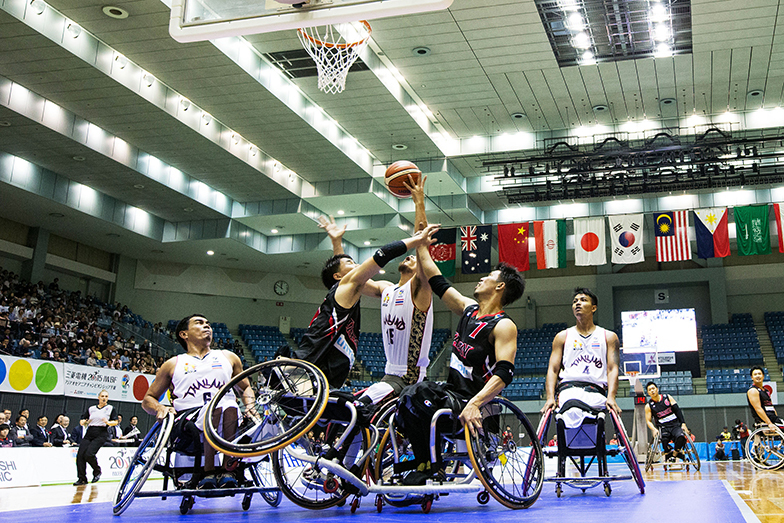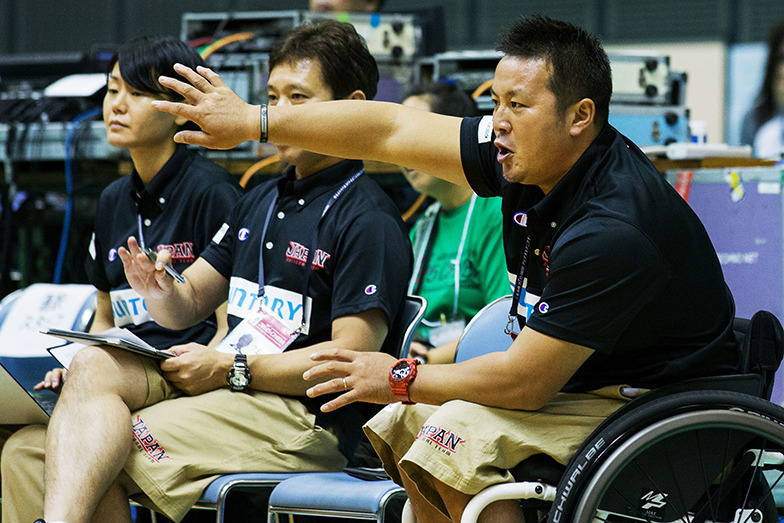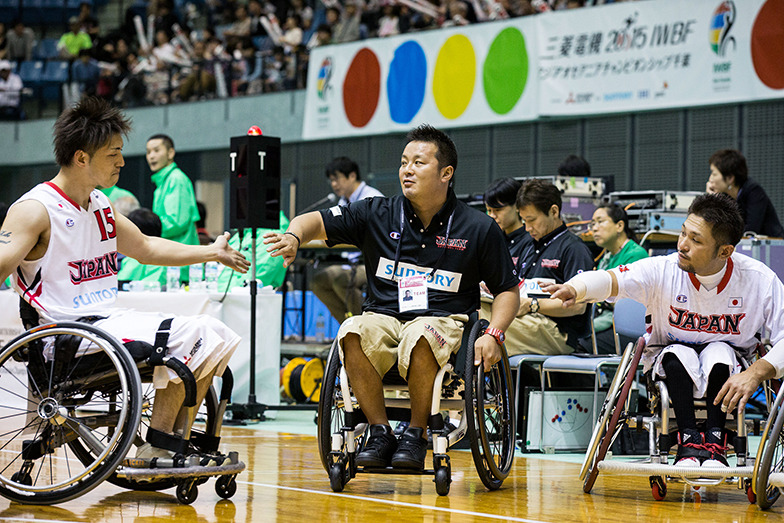Kazuyuki Kyotani
The Japanese men's wheelchair basketball team secured a spot at the Rio de Janeiro Paralympics. Mr. Kazuyuki Kyotani, their assistant coach, fought alongside the players. At 22, while playing in the J-League, he suffered a spinal cord injury in a traffic accident. He then competed as a wheelchair basketball player, participating in four Paralympics starting with Sydney 2000. We asked Mr. Kyotani about key points for watching wheelchair basketball and its appeal.
The players' intricate communication: "This is a sport"
I was originally a professional soccer player. In the fall of 1993, just five months after the J.League's opening season, I suffered a spinal cord injury in a traffic accident. I had to leave my career as a player and began life in a wheelchair. I first encountered wheelchair basketball when a scout came to me. He was a player for the Chiba Hawks, the team I would later join, and also an employee of Urayasu City Hall. But I wasn't very enthusiastic at first. Coming from a professional sports background, I assumed the level wouldn't be that high. That changed completely after seeing the Chiba Hawks play. I was astonished by the high level of play. Then, at the National Sports Festival in Nagoya, where I was practically forced to participate due to a player shortage, I was overwhelmed by the games of the top-tier athletes. The intensity during the games was one thing, but even more striking was the highly sophisticated, detailed conversation between the players and coaches during timeouts. Right after the timeout ended, on the very first play, they were already executing what they had just discussed. "This is sport," I thought, and my entire perception changed. Simultaneously, it was the moment I felt I might be able to grasp again the brilliance and glory of sport that I had lost midway through my aspirations.
After joining the Chiba Hawks, I found commonalities with soccer. For instance, while soccer prohibits hand use, wheelchair basketball involves propelling yourself with your hands—so if a pass drifts backward, you can't catch it. It's about driving the ball forward, forward. Both are team sports with a ball, offensive strategies, and defense. Once I recognized this as soccer, my thinking evolved rapidly. In soccer, I played a playmaker role, so when I consciously controlled the game and passed the ball, it worked incredibly well. After that, I became completely absorbed in wheelchair basketball, competing in four Paralympics until my retirement after the 2012 London Games. Currently, I focus on mentoring the next generation, coaching university soccer teams and serving as assistant coach for the Japanese men's wheelchair basketball national team.

Mitsubishi Electric 2015 IWBF Asia-Oceania Championship Chiba Japan vs. Thailand (October 10)
Classification: Unique to Wheelchair Basketball and Team Roles
For those new to wheelchair basketball, the "classification system" is particularly important to understand. While rules, court dimensions, and basket height are nearly identical to standard basketball, classification is unique to wheelchair basketball. Each player is assigned a point value from 1.0 to 4.5 based on the severity of their disability. The total point value of the five players on the court during a game must not exceed 14 points. This system ensures fairness between teams and allows players with more severe disabilities to compete. My point value is 1.0. I lack abdominal and back muscle function, so I cannot rotate my torso. To support my body, my wheelchair's center of gravity is low, and I cannot move away from the backrest, so I cannot move like players with higher point values.
But within the team, each player has a specific role. Players with relatively higher motor function are called high pointers; they score points and move the ball quickly. On the other hand, low pointers have the role of blocking opponents near the goal with their wheelchairs, preventing them from getting close. There's intense back-and-forth action that's different from the ball scramble. For first-time viewers, it might be interesting to focus not on the high-pointers, but on the low-pointers instead. Shifting your perspective to see how this player's movements enable that player to score might make the unique motions of wheelchair basketball easier to understand.
Tactics are also unique. In wheelchair basketball, stopping an opponent's wheelchair movement immobilizes them. This can be done in any zone. To put it extremely, sometimes only two players are near the basket when the ball is brought up. Conversely, when attacking, you might focus on containing the opponent's key high pointer, then easily attack 4-on-4. Understanding these various tactics and strategies that leverage wheelchair characteristics makes the game even more enjoyable to watch.

The power of sports that shaped me, starting with just watching
Sports were always around me since childhood; it was just a given. Looking back now, I gained so much from soccer and wheelchair basketball. Soccer shaped the foundation of my personality – the competitive streak, the "I'm the best" attitude (laughs). The accident shattered that, forcing me to reevaluate myself. That's when I encountered wheelchair basketball and learned to act for others. Since I couldn't move myself, I had to get that guy moving forward. When I praised a teammate for a great play, they'd praise me back. It felt good, so I'd praise them again. I believe sports shaped me into that kind of person.
Sports also empower those who watch. Even baseball, which I don't usually follow, gets me fired up during the Koshien high school tournament. When the Japanese national volleyball team gets attention, I watch and think, "Wow, that's incredible." It might sound cliché, but it's absolutely true that sports give us inspiration and courage.
I truly believe it starts with watching. Wheelchair basketball still has low recognition, and I imagine most people have never seen it. But I hope people won't judge it without seeing it first. We can't predict what they'll feel or how their hearts will respond when they honestly take those feelings home, but I want them to experience it first.
While dedicating our efforts to developing players, we want to continue our activities so that more people can learn about and enjoy wheelchair basketball as a sport.





